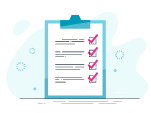5 ways to make hybrid working work for you
Covid-19 accelerated an existing trend: remote working spaces, flexible working hours and agile working are not anything new. In fact, more flexible, hybrid working approaches have long been understood to benefit a team’s wellbeing.
Enforced remote working has become the norm for many due to the pandemic. In a way, this mass trial in homeworking has given employees the chance to test out working from home, that they may not have otherwise had. People have enjoyed benefits such as no commute, more time with family and a better work-life balance. Many employees and, significantly, their employers have also noted increased productivity, particularly for quieter, more focused work.
But the option to work remotely does not mean office space should become redundant. For some, the office environment may still be preferable. Collaboration spaces are an integral part of establishing company culture. It is where innovation and collaboration can be achieved, and of equal importance, where workers can socialise with colleagues. A large study of over 32,000 people across 10 countries by Steelcase found the main reasons for getting back to the office were the connection to company purpose, a sense of community and support for their productivity.
On balance, researchers are finding that most workers would like to see a combination of the two. The same Steelcase study revealed 87% of business leaders want to offer increased flexibility, with 72% expecting a hybrid working model. This is compared with just 23% expecting the office to be their main location for working. These feelings are reinforced by employees, with 54% expecting to work from home at least once a week.
What is hybrid working?
A hybrid working model blends the benefits of both homeworking and office working. It can provide businesses with the flexibility and independence that is enjoyed with remote working, as well as the sociality and structure of working in an office.

This model of working will be crucial for reaching an effective balance between collaborative time and quiet, focused working, and many big tech companies, including Salesforce, Google, Amazon and Facebook are already embracing hybrid working.
And with over 40% of the global workforce reportedly thinking about leaving their employer this year, a considered and calculated approach to hybrid working will be crucial for organisations to attract and retain diverse talent.

So, how do you make a hybrid working model work for you?
We’ve outlined 5 key steps to help you achieve the full benefits of a hybrid approach to remote working and office working.
1. Manage by outcomes
It goes without saying that merely being present in the office does not necessarily equate to being productive. Productivity can be measured in other ways. Successful organisations are already shifting team management from behaviour-based monitoring to an outcome-based mindset. This means that instead of simply measuring performance based on what an employee is seen to be doing, managers are considering all other deliverables and outputs and taking a more holistic approach to management.
Using measurement systems such as Key Performance Indicators (KPIs) and Objective Key Results (OKRs) or SMART goals are useful for both in-office and remote employees. Recording goals in a systemised way such as this provides workers with the necessary visibility of what they should focus on and gives managers a framework to measure performance.
To shift towards managing by outcomes, there are some useful points to consider:
- Are your existing performance management systems suitable for remote working environments?
- Ensure regular one-on-one meetings between managers and employees to establish objectives and discuss performance.
- Establish mechanisms to identify and reward good performance and address poor performance for hybrid workers.
Ultimately, establishing an environment of mutual trust is key.
2. Make employee wellbeing a top priority
The statistics on both mental and physical wellbeing throughout the pandemic make for grim reading, and the effects that poor wellbeing have on work-related outcomes are well-documented.
Research into digital behaviours over the past year demonstrate that despite increases in self-assessed productivity, the global workforce is exhausted. 54% of Microsoft’s global survey respondents feel overworked. 39% feel exhausted. 1 in 5 believe their employer doesn’t care about their work-life balance.
Making employee wellbeing a priority does not mean simply offering a tokenistic gym membership or free fruit. It means actively listening to employee concerns, responding appropriately and embedding wellbeing into everyday communications. This may look like:
- Providing wellbeing training to staff on managing work-life balance whilst hybrid working.
- Ensuring managers can spot potential signs of poor wellbeing and feel comfortable to have appropriate wellbeing conversations.
- Signposting ongoing mental health information and support for employees.
Moving forward, business leaders must seek to prioritise employee wellbeing in real ways, which includes addressing burnout and exhaustion. Leaders should focus on creating a culture wherein breaks are respected and encouraged, working longer hours is not the norm, and employees feel able to speak out about any health and wellbeing concerns freely.
3. Innovate new approaches to sustaining company culture
Directly linking to employee wellbeing is the important feeling of belonging that good company culture brings. The relationships we share with colleagues have a huge impact on our performance, stress levels, and even happiness.
This sense of community can be harder to achieve if employees are not in the same physical environment as often. But it boils down to ensuring employees feel connected, even if this is not through proximity.
Verbalising and reinforcing the shared purpose of a team is a good way to foster this remotely. Maintaining visibility and transparency within teams is also important. This can be harder to achieve virtually, but employing the right technological tools can help leaders create this feeling of connectedness wherever your employees may be located.
Another effective approach is to create spaces that are fit for purpose. The office should be re-imagined as a collaboration hub that exists to offer extensive positive opportunities, including innovation, productivity, community and career development.
Business leaders can sustain strong cultures by creating places where people want to work, with space to learn, socialise and collaborate.
4. Do not neglect health and safety
A key expectation for moving forward after the pandemic is for safer workplaces. 73% of US employees reported their top concerns for returning to the office were air quality and adherence to safety protocols. This may mean behavioural strategies including social distancing and mask wearing need to be embedded into amendments to the physical environment.
However, the duty of care that employers have for staff’s physical and mental wellbeing is not limited to the physical office space. Actions also need to be taken to avoid the health and safety risks associated with homeworking. Examples include both physical health risks (e.g., musculoskeletal injuries that occur as a result of poorly set up home workstations) and mental health risks (e.g., depression or anxiety stemming from poorly managed workloads at home).
To mitigate these risks, leaders should ensure that health and safety management systems are fit for purpose to accommodate hybrid working. Training should be provided, full homeworking H&S assessments should be conducted, and all employees should have access to the necessary health and safety processes.
5. Intentional communication to ensure employees feel constantly informed
Working full-time in the office gives employees natural opportunities to pick up on what’s happening, through ‘water-cooler’ moments, bumping into people in the hallway, or grabbing a coffee in the work café. It is much harder to recreate these moments virtually; with the spontaneity gone, meetings can feel far more formal.
As such, communication needs to be seen as the responsibility of everyone. The risks of poorly managed communication include ineffective information flow, exclusion of remote team members, knowledge gaps and barriers to effective communication.
Steps to ensure effective communication may include:
- A remote-first culture: all meetings are held online by default to ensure all attendees have a consistent experience of the meeting.
- Teams are given responsibility for creating their own communication guidelines. These may include their preferred digital method for communication and how often they will meet physically.
- Scheduling regular opportunities for team building and employee engagement.
For managers and business leaders, communication should become more intentional. Employees need to be kept informed about everything – be it good or bad.
Next steps
Whatever your preferred approach to post-pandemic working, employees are calling for solid plans to be communicated. McKinsey surveyed 5000 workers and found that 40% of respondents reported that they had not heard about any vision from their organisations, with another 28% saying that what they’ve heard remains vague.
This uncertainty is causing anxiety among employees: 47% said that the lack of a clear vision of a post-pandemic world is cause for concern. Organisations need to consider their next steps and communicate them clearly to their workforce.
Hybrid working is one approach for returning to work following the pandemic. Download our free Return to Work Checklist for more information about how you can prepare.

Return to Work Checklist
Our free checklist outlines key steps you can take to prepare for the return to work and keep your workers safe in the new normal.
Tags:
